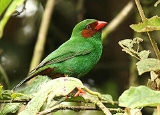
Tanager
Encyclopedia
- See also Tanager (disambiguation)Tanager (disambiguation)Tanager is a family of birds. It may also refer to:Birds*Bay-headed Tanager*Hepatic Tanager*Passerini's Tanager*Summer Tanager*Scarlet Tanager*Spotted Tanager*Western Tanager*etc...
The tanagers (sg. icon) comprise the bird family
Family (biology)
In biological classification, family is* a taxonomic rank. Other well-known ranks are life, domain, kingdom, phylum, class, order, genus, and species, with family fitting between order and genus. As for the other well-known ranks, there is the option of an immediately lower rank, indicated by the...
Thraupidae, in the order Passeriformes. The family has an American
Americas
The Americas, or America , are lands in the Western hemisphere, also known as the New World. In English, the plural form the Americas is often used to refer to the landmasses of North America and South America with their associated islands and regions, while the singular form America is primarily...
distribution.
There were traditionally about 240 species of tanagers, but the taxonomic treatment of this family's members is currently in a state of flux. As more of these birds are studied using modern molecular techniques it is expected that some genera may be relocated elsewhere. Already species in the genera Euphonia
Euphonia
Euphonias are members of the genus Euphonia, a group of Neotropical birds in the finch family. Euphonia contains close to 27 species. They and the chlorophonias comprise the subfamily Euphoniinae....
and Chlorophonia
Chlorophonia
Chlorophonia is a genus of finches endemic to the Neotropics. The English group name for the five species that constitute the genus is also chlorophonia. The collective term for the genus is chlorophonias...
, which were once considered part of the tanager family, are now treated as members of Fringillidae, in their own subfamily (Euphoniinae
Euphoniinae
Euphoniinae is a subfamily of finches endemic to the Neotropics. It contains two genera, Euphonia and Chlorophonia.-Species list:SUBFAMILY EUPHONIINAE*Genus Euphonia: the euphonias** Jamaican Euphonia, ** Plumbeous Euphonia, ...
). Likewise the genera Piranga
Piranga
Piranga is a genus of birds long placed in the tanager family, but now considered relatives of the Cardinalis cardinals.Similar in shape and habits to the true tanagers, their coloration betrays their actual relationships. They are essentially red, orange or yellow all over, except the tail and...
(which includes the Scarlet Tanager
Scarlet Tanager
The Scarlet Tanager is a medium-sized American songbird. Formerly placed in the tanager family , it and other members of its genus are now classified in the cardinal family . The species's plumage and vocalizations are similar to other members of the cardinal family.-Description:Adults have pale...
, Summer Tanager
Summer Tanager
The Summer Tanager, Piranga rubra, is a medium-sized American songbird. Formerly placed in the tanager family , it and other members of its genus are now classified in the cardinal family...
, and Western Tanager
Western Tanager
The Western Tanager, Piranga ludoviciana, is a medium-sized American songbird. Formerly placed in the tanager family , it and other members of its genus are now classified in the cardinal family...
), Chlorothraupis
Chlorothraupis
Chlorothraupis is a genus of bird in the family Cardinalidae. It was long considered to be tanagers as their common names suggest, but this is false...
, and Habia appear to be members of the Cardinal
Cardinal (bird)
The Cardinals or Cardinalidae are a family of passerine birds found in North and South America. The South American cardinals in the genus Paroaria are placed in another family, the Thraupidae ....
family, and have been reassigned to that family by the AOU
American Ornithologists' Union
The American Ornithologists' Union is an ornithological organization in the USA. Unlike the National Audubon Society, its members are primarily professional ornithologists rather than amateur birders...
.
Description
Tanagers are small to medium-sized birds. The shortest-bodied species, the White-eared ConebillWhite-eared Conebill
The White-eared Conebill is a species of bird in the Thraupidae family.It is found in Colombia, Panama, and Venezuela. Its natural habitats are subtropical or tropical moist lowland forests and heavily degraded former forest.-References:* BirdLife International 2004. . Downloaded on 25 July...
, is 9 cm (3.8 in) long and weighs 7 grams, barely smaller than the Short-billed Honeycreeper
Short-billed Honeycreeper
The Short-billed Honeycreeper is a species of bird in the Thraupidae family.It is found in Bolivia, Brazil, Colombia, Ecuador, Peru, Suriname, and Venezuela.Its natural habitat is subtropical or tropical moist lowland forests....
. The longest, the Magpie Tanager
Magpie Tanager
The Magpie Tanager is a South American species of tanager. It is the only member of the monotypic genus Cissopis. As suggested by its common name, this blue-black and white species is superficially reminiscent of a European Magpie...
is 28 cm (11 in) and weighs 76 grams (2.7 oz). The heaviest is the White-capped Tanager
White-capped Tanager
The White-capped Tanager. Sericossypha albocristata. At a weight of 114 g and a length of 24 cm , it is the heaviest but not the longest species of tanager. This species is glossy black overall with a large white crown and a red throat...
which weighs 114 grams (4 oz) and measures about 24 cm (9.5 in). Both sexes are usually the same size and weight. Tanagers are often brightly colored, but some species are black and white. Birds in their first year are often duller or a different color altogether. Males are typically more brightly coloured than females.
Most tanagers have short, rounded wings. The shape of the bill
Beak
The beak, bill or rostrum is an external anatomical structure of birds which is used for eating and for grooming, manipulating objects, killing prey, fighting, probing for food, courtship and feeding young...
seems to be linked to the species' foraging
Foraging
- Definitions and significance of foraging behavior :Foraging is the act of searching for and exploiting food resources. It affects an animal's fitness because it plays an important role in an animal's ability to survive and reproduce...
habits.
Distribution
Tanagers are restricted to the New WorldNew World
The New World is one of the names used for the Western Hemisphere, specifically America and sometimes Oceania . The term originated in the late 15th century, when America had been recently discovered by European explorers, expanding the geographical horizon of the people of the European middle...
and mainly to the tropics
Tropics
The tropics is a region of the Earth surrounding the Equator. It is limited in latitude by the Tropic of Cancer in the northern hemisphere at approximately N and the Tropic of Capricorn in the southern hemisphere at S; these latitudes correspond to the axial tilt of the Earth...
. About 60% of tanagers live in South America, and 30% of these species live in the Andes
Andes
The Andes is the world's longest continental mountain range. It is a continual range of highlands along the western coast of South America. This range is about long, about to wide , and of an average height of about .Along its length, the Andes is split into several ranges, which are separated...
. Most species are endemic
Endemic (ecology)
Endemism is the ecological state of being unique to a defined geographic location, such as an island, nation or other defined zone, or habitat type; organisms that are indigenous to a place are not endemic to it if they are also found elsewhere. For example, all species of lemur are endemic to the...
to a relatively small area.
Behaviour
Most tanagers live in pairs or in small groups of 3-5 individuals. These groups may consist simply of parents and their offspring. Birds may also be seen in single species or mixed flocks. Many tanagers are thought to have dull songs, though some are elaborate.Diet
Tanagers are omnivorous, and their diet varies from genus to genus. They have been seen eating fruitFruit
In broad terms, a fruit is a structure of a plant that contains its seeds.The term has different meanings dependent on context. In non-technical usage, such as food preparation, fruit normally means the fleshy seed-associated structures of certain plants that are sweet and edible in the raw state,...
s, seed
Seed
A seed is a small embryonic plant enclosed in a covering called the seed coat, usually with some stored food. It is the product of the ripened ovule of gymnosperm and angiosperm plants which occurs after fertilization and some growth within the mother plant...
s, nectar, flower parts and insects. Many pick insects off branches. Other species look for insects on the underside of leaves. Yet others wait on branches until they see a flying insect
Insect
Insects are a class of living creatures within the arthropods that have a chitinous exoskeleton, a three-part body , three pairs of jointed legs, compound eyes, and two antennae...
and catch it in the air. Many of these particular species inhabit the same areas, but these specializations alleviate competition.
Reproduction
The breeding season begin in March through until June in temperate areas and in September through October in South AmericaSouth America
South America is a continent situated in the Western Hemisphere, mostly in the Southern Hemisphere, with a relatively small portion in the Northern Hemisphere. The continent is also considered a subcontinent of the Americas. It is bordered on the west by the Pacific Ocean and on the north and east...
. Some species are territorial while others build their nests closer together. There is little information on tanager breeding behavior or whether they are monogamous or polygamous. Males show off their brightest feathers to potential mates and rival males. Some species' courtship rituals involve bowing and tail lifting.
Most tanagers build cup nests on branches in trees. Some nests
Bird nest
A bird nest is the spot in which a bird lays and incubates its eggs and raises its young. Although the term popularly refers to a specific structure made by the bird itself—such as the grassy cup nest of the American Robin or Eurasian Blackbird, or the elaborately woven hanging nest of the...
are almost globular. Entrances are usually built on the side of the nest. The nests can be shallow or deep. The species of the tree they choose to build their nest in and the nest's position varies among genera. Most species nest in an area hidden by very dense vegetation. There is still no information on the nests of some species.
The clutch
Clutch (eggs)
A clutch of eggs refers to all the eggs produced by birds or reptiles, often at a single time, particularly those laid in a nest.In birds, destruction of a clutch by predators, , results in double-clutching...
size is 3–5 eggs
Bird egg
Bird eggs are laid by females and incubated for a time that varies according to the species; a single young hatches from each egg. Average clutch sizes range from one to about 17...
. The female incubates the eggs and builds the nest, but the male may feed the female while she incubates. Both sexes feed the young. Five species have helpers assist in feeding the young. These helpers are thought to be the previous year's nestlings.
Systematics
Phylogenetic studies suggest the true tanagers form three main groups two of which consist of several smaller, well-supported clades. The list below is an attempt using information gleaned from the latest studies to organise them into coherent related groups, and as such may contain groupings not yet accepted by or are under review by the various ornithological taxonomy authorities.Group 1
Mainly dull-coloured forms
Flowerpiercer
The flowerpiercers are the members of two genera of tanagers, Diglossa and Diglossopis. The latter genus is sometimes subsumed into the former, but at present most authorities maintain them as separate. Based on mtDNA, the Indigo Flowerpiercer, which traditionally has been placed in Diglossopis,...
group (Also contains Haplospiza
Haplospiza
Haplospiza is a small genus of birds in the Thraupidae family. Sometimes classified in the bunting and American sparrow family Emberizidae, more recent studies have shown it to belong in the Thraupidae. Its two members breed in subtropical or tropical moist forest in Central and South America...
, Catamenia
Catamenia (genus)
Catamenia is a genus of atypical seedeaters. Formerly placed in the Emberizidae, they are now considered tanagers.-Species List:* Band-tailed Seedeater, Catamenia analis* Plain-colored Seedeater, Catamenia inornata...
, Acanthidops, Diglossa
Diglossa (bird)
Diglossa is a genus of flowerpiercers in the family Thraupidae. Sometimes classified in the bunting and American sparrow family Emberizidae, more recent studies have shown it to belong in the Thraupidae...
, Diglossopis
Diglossopis
Diglossopis is a genus of blue flowerpiercers in the family Thraupidae. They are closely related to the genus Diglossa, and some retain all flowerpiercers in that genus. They were formerly classified in the bunting and American sparrow family Emberizidae, more recent studies have shown it to belong...
, Phrygilus
Phrygilus
Phrygilus is a genus of mainly Andean seed-eating tanagers commonly known as sierra-finches. Phrygilos means finch in Ancient Greek. Sometimes classified in the bunting and American sparrow family Emberizidae, more recent studies have shown them to belong in the Thraupidae...
and Sicalis
Sicalis
Sicalis is a genus of bird in the Thraupidae family. Sometimes classified in the bunting and American sparrow family Emberizidae, more recent studies have shown it to belong in the Thraupidae.It contains the following species:...
traditionally in the Emberizidae
Emberizidae
The Emberizidae are a large family of passerine birds. They are seed-eating birds with a distinctively shaped bill.In Europe, most species are called buntings. In North America, most of the species in this family are known as sparrows, but these birds are not closely related to the sparrows, the...
) This group despite having a rather varied bill morphology shows marked plumage similarities. Most are largely grey, blue, or black, and numerous have rufous
Rust (color)
Rust is a red-brown-orange color resembling iron oxide. It is a commonly used color in stage lighting, and appears roughly the same color as photographic safelights when used over a standard tungsten light source. The color is number 777 in the swatch book....
on the underparts:
- Genus ConirostrumConirostrumTypical conebills are the tanager genus Conirostrum. They are small tanagers found in the forests of South America. They feed in pairs or small flocks by gleaning insects from foliage....
– typical conebills (10 species) - Genus Oreomanes – Giant Conebill
- Genus Xenodacnis – Tit-like Dacnis
- Genus CatameniaCatamenia (genus)Catamenia is a genus of atypical seedeaters. Formerly placed in the Emberizidae, they are now considered tanagers.-Species List:* Band-tailed Seedeater, Catamenia analis* Plain-colored Seedeater, Catamenia inornata...
(3 species) - Genus DiglossaDiglossa (bird)Diglossa is a genus of flowerpiercers in the family Thraupidae. Sometimes classified in the bunting and American sparrow family Emberizidae, more recent studies have shown it to belong in the Thraupidae...
– typical flowerpiercers (14 species) - Genus DiglossopisDiglossopisDiglossopis is a genus of blue flowerpiercers in the family Thraupidae. They are closely related to the genus Diglossa, and some retain all flowerpiercers in that genus. They were formerly classified in the bunting and American sparrow family Emberizidae, more recent studies have shown it to belong...
– blue flowerpiercers (4 species) - Genus HaplospizaHaplospizaHaplospiza is a small genus of birds in the Thraupidae family. Sometimes classified in the bunting and American sparrow family Emberizidae, more recent studies have shown it to belong in the Thraupidae. Its two members breed in subtropical or tropical moist forest in Central and South America...
(2 species). Paraphyletic with 2 species of sierra-finch PhrygilusPhrygilusPhrygilus is a genus of mainly Andean seed-eating tanagers commonly known as sierra-finches. Phrygilos means finch in Ancient Greek. Sometimes classified in the bunting and American sparrow family Emberizidae, more recent studies have shown them to belong in the Thraupidae... - Genus Acanthidops – Peg-billed Finch
- Genus PhrygilusPhrygilusPhrygilus is a genus of mainly Andean seed-eating tanagers commonly known as sierra-finches. Phrygilos means finch in Ancient Greek. Sometimes classified in the bunting and American sparrow family Emberizidae, more recent studies have shown them to belong in the Thraupidae...
- sierra-finches (11 species) - Genus SicalisSicalisSicalis is a genus of bird in the Thraupidae family. Sometimes classified in the bunting and American sparrow family Emberizidae, more recent studies have shown it to belong in the Thraupidae.It contains the following species:...
– yellow-finches (12 species). Paraphyletic with PhrygilusPhrygilusPhrygilus is a genus of mainly Andean seed-eating tanagers commonly known as sierra-finches. Phrygilos means finch in Ancient Greek. Sometimes classified in the bunting and American sparrow family Emberizidae, more recent studies have shown them to belong in the Thraupidae...
b) True seedeater
Seedeater
The seedeaters are a form taxon of seed-eating passerine birds with a distinctively conical bill.Most are Central and South American birds that were formerly placed in the American sparrow family , but are now known to be tanagers closely related to Darwins finches...
s. Traditionally placed in Emberizidae
Emberizidae
The Emberizidae are a large family of passerine birds. They are seed-eating birds with a distinctively shaped bill.In Europe, most species are called buntings. In North America, most of the species in this family are known as sparrows, but these birds are not closely related to the sparrows, the...
. These genera share a particular foot-scute
Scute
A scute or scutum is a bony external plate or scale, as on the shell of a turtle, the skin of crocodilians, the feet of some birds or the anterior portion of the mesonotum in insects.-Properties:...
pattern which suggests that they may form a monophyletic group:
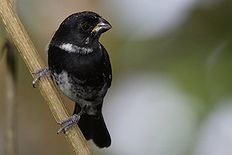
- Genus SporophilaSporophilaSporophila is a genus of Neotropical birds in the Thraupidae family. The seed finches are sometimes also included in this genus.They are relatively small with stubby, conical bills adapted for feeding on seeds and alike...
– typical seedeaters (some 55 species) - Genus OryzoborusOryzoborusOryzoborus is a genus of bird in the Thraupidae family. Sometimes classified in the bunting and American sparrow family Emberizidae, more recent studies have shown it to belong in the Thraupidae, and some have argued for merging it into Sporophila....
(6 species) - Genus Dolospingus – White-naped Seedeater
- Genus Charitospiza – Coal-crested Finch
c) "Yellow-rumped" clade:
- Genus HeterospingusHeterospingusHeterospingus is a small genus of medium-sized tanagers found in forests of South America.-Species List:* Sulphur-rumped Tanager, Heterospingus rubrifrons* Scarlet-browed Tanager, Heterospingus xanthopygius...
(2 species) - Genus ChrysothlypisChrysothlypisChrysothlypis is a small genus of tanagers found in humid forests of southern Central America and the Chocó in South America. The males of these small birds are strikingly yellow and black or red and white, while the females are much duller....
(2 species) - Genus HemithraupisHemithraupisA small genus of tanagers found in forests of South America.-Species list:* Guira Tanager, Hemithraupis guira* Rufous-headed Tanager, Hemithraupis ruficapilla* Yellow-backed Tanager, Hemithraupis flavicollis...
(3 species)
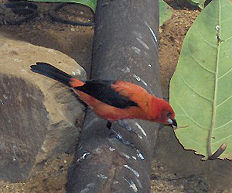
Coryphospingus
A small genus of finch-like tanagers found in South America, Coryphospingus was formerly classified in the family Emberizidae along with the buntings and American sparrows.-Species list:* Pileated Finch, Coryphospingus pileatus...
& Volatinia traditionally placed in the Emberizidae
Emberizidae
The Emberizidae are a large family of passerine birds. They are seed-eating birds with a distinctively shaped bill.In Europe, most species are called buntings. In North America, most of the species in this family are known as sparrows, but these birds are not closely related to the sparrows, the...
):
- Genus RamphocelusRamphocelusRamphocelus is a Neotropical genus of birds of the tanager family. They have enlarged shiny whitish or bluish-grey lower mandibles, which are pointed upwards in display. However, this is greatly reduced in the females of most species...
– silver-billed tanagers (9 species) - Genus LanioLanioLanio is the genus of shrike-tanagers.-Species list:* Fulvous Shrike-tanager, Lanio fulvus* White-winged Shrike-tanager, Lanio versicolor* Black-throated Shrike-tanager, Lanio aurantius...
– shrike-tanagers (4 species) - Genus Eucometis – Gray-headed Tanager
- Genus TachyphonusTachyphonusTachyphonus is a genus of tanagers.-Species list:* Flame-crested Tanager, Tachyphonus cristatus* Yellow-crested Tanager, Tachyphonus rufiventer* Fulvous-crested Tanager, Tachyphonus surinamus...
(8 species) - Genus Trichothraupis – Black-goggled Tanager
- Genus Stephanophorus – Diademed Tanager
- Genus CoryphospingusCoryphospingusA small genus of finch-like tanagers found in South America, Coryphospingus was formerly classified in the family Emberizidae along with the buntings and American sparrows.-Species list:* Pileated Finch, Coryphospingus pileatus...
(2 species) - Genus Volatinia – Blue-black Grassquit
e) "Blue Finch" clade. Relationships within Thraupidae uncertain but may be related to "Poospiza" clade:
- Genus Porphyrospiza - Blue Finch
- Genus? Phrygilus alaudinus - Band-tailed Sierra-finch
f) The "Poospiza" clade - a diverse but close-knit group containing both warbler and finch-like forms:
- Genus PoospizaPoospizaPoospiza is a genus of finch-like tanagers found in both the South American lowlands and the Andes mountains. Generally they are arboreal feeders in light woodland and scrub...
– Warbling-finches (15 species) - Genus CompsospizaCompsospizaCompsospiza is a genus of South American birds known as mountain-finches...
- Mountain-finches (2 species) - Genus Cnemoscopus – Gray-hooded Bush Tanager
- Genus HemispingusHemispingusHemispingus is a genus of warbler-like tanagers. They are found in highland forest in South America, especially in the Andes.- Species list :* Black-capped Hemispingus, Hemispingus atropileus* Orange-browed Hemispingus, Hemispingus calophrys...
– hemispinguses (12 species) - Genus ThlypopsisThlypopsisThlypopsis is a genus of tanagers.-Species list:* Fulvous-headed Tanager, Thlypopsis fulviceps* Rufous-chested Tanager, Thlypopsis ornata* Brown-flanked Tanager, Thlypopsis pectoralis* Orange-headed Tanager, Thlypopsis sordida...
(6 species) - Genus Pyrrhocoma – Chestnut-headed Tanager
- Genus Cypsnagra – White-rumped Tanager
- Genus Nephelornis – Pardusco
g) Grass & Pampa-finches. Relationships within Thraupidae uncertain but together form a well-supported clade:
- Genus EmberizoidesEmberizoidesEmberizoides is a small genus of finch-like tanagers found in grassy areas in Central and South America.-Species list:* Wedge-tailed Grass-finch, Emberizoides herbicola* Duida Grass-finch, Emberizoides duidae...
(3 species) - Genus EmbernagraEmbernagraEmbernagra is a genus of finch-like tanagers.-Species list:* Pale-throated Serra-finch, Embernagra longicauda* Great Pampa-finch, Embernagra platensis...
(2 species)

Tanager-finch
The Tanager-finch is a songbird species. In the recent past usually placed in the Emberizidae family, it actually seems to be, as its common name implies, a kind of tanager . But its precise affinities are unclear. It is placed in the monotypic genus Oreothraupis.It is found in Colombia and Ecuador...
) whose members when studied will no doubt be relocated to other clades:
- Genus MelanoderaMelanoderaMelanodera is a genus of Patagonian seed-eating tanagers.-Species list:* White-bridled Finch or Canary-winged Finch, Melanodera melanodera* Yellow-bridled Finch, Melanodera xanthogramma...
(2 species) - Genus Rowettia – Gough Island Finch
- Genus NesospizaNesospizaNesospiza is a genus of seed-eating tanagers found on the Tristan da Cunha archipelago in the South Atlantic Ocean.-Species list:* Inaccessible Island Finch, Nesospiza acunhae* Nightingale Island Finch, Nesospiza questi...
(2 species) - Genus Gubernatrix – Yellow Cardinal
- Genus Idiopsar – Short-tailed Finch
- Genus Piezorhina – Cinereous Finch
- Genus Xenospingus – Slender-billed Finch
- Genus IncaspizaIncaspizaThe Inca-finches are a genus of finch-like tanagers. They were formerly placed in the Emberizidae. Both their scientific and common name refer to the Incan civilization. They are endemic to arid scrub in central and northern Peru. Buff-bridled, Gray-winged and Little Inca-finch are restricted to...
– inca-finches (5 species) - Genus Coryphaspiza – Black-masked Finch
- Genus Rhodospingus – Crimson-breasted Finch
- Genus Donacospiza – Long-tailed Reed-finch (may be related to PoospizaPoospizaPoospiza is a genus of finch-like tanagers found in both the South American lowlands and the Andes mountains. Generally they are arboreal feeders in light woodland and scrub...
)
i) Basal forms in group 1:
- Genus ConothraupisConothraupisConothraupis is a genus of tanagers.-Species list:* Black-and-white Tanager, Conothraupis speculigera* Cone-billed Tanager, Conothraupis mesoleuca...
(2 species) - Genus Orchesticus – Brown Tanager
- Genus CreurgopsCreurgopsCreurgops is a genus of relatively large and heavy-billed tanagers. They are found in the canopy of humid montane forest in the Andes of South America. They are mainly slaty grey above and rufous below, except in the male Slaty Tanager where the underparts also are slaty grey. Males of both species...
(2 species)
Group 2
"Typical" colourful Tanagers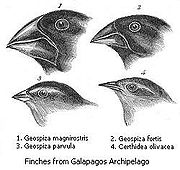
- Genus ThraupisThraupisThraupis is a genus of birds of the tanager family occurring from Mexico to Argentina. Some are familiar species with large ranges. As currently defined the genus includes 9 species, but this includes species from two separate clades. Consequently, the genus is paraphyletic and two species...
- T. abbas & episcopus at least - Genus TangaraTangara (genus)Tangara is a large genus of birds of the tanager family. It includes about 50 species, but as currently defined the genus is polyphyletic. All are from the Neotropics, and while most are fairly widespread, some have small distributions and are threatened. They are fairly small, ranging in size from...
(about 50 species)
b) The "Tholospiza" - Darwin's finches
Darwin's finches
Darwin's finches are a group of 14 or 15 species of passerine birds. It is still not clear which bird family they belong to, but they are not related to the true finches. They were first collected by Charles Darwin on the Galápagos Islands during the second voyage of the Beagle...
, grassquit
Grassquit
Grassquits are small, tropical birds currently placed in the tanager bird family Thraupidae, although they had earlier been thought to be of the family Emberizidae...
s, atypical honeycreeper
Honeycreeper
The typical honeycreepers are small birds in the tanager family. They are found in the tropical New World from Mexico south to Brazil.They occur in the forest canopy, and, as the name implies, they are specialist nectar feeders with long curved bills....
s and some seedeater
Seedeater
The seedeaters are a form taxon of seed-eating passerine birds with a distinctively conical bill.Most are Central and South American birds that were formerly placed in the American sparrow family , but are now known to be tanagers closely related to Darwins finches...
s. The finch-like forms in this clade were formerly classified in the Emberizidae
Emberizidae
The Emberizidae are a large family of passerine birds. They are seed-eating birds with a distinctively shaped bill.In Europe, most species are called buntings. In North America, most of the species in this family are known as sparrows, but these birds are not closely related to the sparrows, the...
:
- Genus GeospizaGeospizaGeospiza is a genus of bird in the Thraupidae family; all species of Geospiza are endemic to the Galápagos Islands; together with related genera they are collectively known as Darwin's finches...
– ground finches (6 species) - Genus CamarhynchusCamarhynchusCamarhynchus is a genus of bird in the Thraupidae family; all species of Camarhynchus are endemic to the Galápagos Islands, and together with related genera they are collectively known as Darwin's finches...
– tree finches (5 species) - Genus Platyspiza - Vegetarian Finch
- Genus Certhidea – Warbler Finch
- Genus Pinaroloxias – Cocos Island Finch
- Genus Melopyrrha – Cuban Bullfinch
- Genus Coereba – Bananaquit. Formerly placed in own family Coerebidae
- Genus TiarisTiarisTiaris is a genus of songbirds in the tanager family , containing the bulk of the grassquits. In late 20th century sources in particular, it was very often allied to the American sparrows and placed in the Emberizidae family....
– grassquits (5 species) - polyphyletic - Genus Loxipasser – Yellow-shouldered Grassquit
- Genus Euneornis – Orangequit
- Genus Melanospiza – St. Lucia Black Finch
- Genus LoxigillaLoxigillaLoxigilla is the genus of Antillean bullfinches, birds in the Thraupidae family. Sometimes classified in the bunting and American sparrow family Emberizidae, more recent studies have shown it to belong in the tanager family....
– Antillean bullfinches (3 species) - polyphyletic
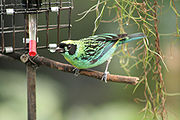
- Genus Cyanicterus – Blue-backed Tanager
- Genus BangsiaBangsiaBangsia is a genus of tanagers containing five species. They are native to humid forests in Colombia, Ecuador, Panama and Costa Rica. Wetmorethraupis is a close relative.-Species list:* Blue-and-gold Tanager, Bangsia arcaei...
– (5 species) - Genus ButhraupisButhraupisButhraupis is a genus of South American birds in the tanager family. The four species are found in highland forest, woodland and shrub in the Andes and Santa Marta Mountains. They are among the largest tanagers, and all have a mainly yellow, blue and black plumage...
– (4 species) - Genus Chlorornis – Grass-green Tanager
- Genus Wetmorethraupis – Orange-throated Tanager
- Genus AnisognathusAnisognathusAnisognathus is a genus of tanagers found in highland forests and woodlands in South America.-Species list:* Santa Marta Mountain-tanager, Anisognathus melanogenys* Lacrimose Mountain-tanager, Anisognathus lacrymosus...
– (5 species) - Genus Dubusia – Buff-breasted Mountain-tanager
- Genus Delothraupis – Chestnut-bellied Mountain-tanager
- Genus? Saltator rufiventris - Rufous-bellied 'Saltator'
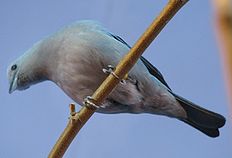
- Genus ThraupisThraupisThraupis is a genus of birds of the tanager family occurring from Mexico to Argentina. Some are familiar species with large ranges. As currently defined the genus includes 9 species, but this includes species from two separate clades. Consequently, the genus is paraphyletic and two species...
- Thraupis bonariensis at least belongs here - Genus Pipraeidea – Fawn-breasted Tanager
- Genus IridosornisIridosornisIridosornis is a genus of tanagers.-Species list:* Purplish-mantled Tanager, Iridosornis porphyrocephala* Yellow-throated Tanager, Iridosornis analis* Golden-collared Tanager, Iridosornis jelskii...
(5 species)
e) Typical multicoloured tanagers (includes Paroaria
Paroaria
Paroaria, the red-headed cardinals or cardinal-tanagers , are a genus of tanagers. They were until recently placed in the family Emberizidae.Five or six species are placed here...
traditionally placed in either Emberizidae
Emberizidae
The Emberizidae are a large family of passerine birds. They are seed-eating birds with a distinctively shaped bill.In Europe, most species are called buntings. In North America, most of the species in this family are known as sparrows, but these birds are not closely related to the sparrows, the...
or Cardinalidae):
- Genus DiucaDiucaDiuca is a small genus of Andean seed-eating tanagers.-Species list:* White-winged Diuca-finch, Diuca speculifera* Common Diuca-finch, Diuca diuca...
(2 species) - Genus LophospingusLophospingusLophospingus is a genus of bird in the Thraupidae family. Sometimes classified in the bunting and American sparrow family Emberizidae, more recent studies have shown it to belong in the tanager family.It contains the following species:...
(2 species) - Genus Neothraupis – White-banded Tanager
- Genus Cissopis – Magpie Tanager
- Genus ParoariaParoariaParoaria, the red-headed cardinals or cardinal-tanagers , are a genus of tanagers. They were until recently placed in the family Emberizidae.Five or six species are placed here...
(5–6 species) - Genus SchistochlamysSchistochlamysSchistochlamys is a genus of tanagers.-Species list:* Cinnamon Tanager, Schistochlamys ruficapillus* Black-faced Tanager, Schistochlamys melanopis...
(2 species)
f) Green & Golden-collared Honeycreepers:
- Genus Chlorophanes – Green Honeycreeper
- Genus Iridophanes – Golden-collared Honeycreeper
g) Typical honeycreepers and relatives:
- Genus Tersina – Swallow Tanager
- Genus Cyanerpes, the typical honeycreepers (4 species)
- Genus Pseudodacnis – Turquoise Dacnis-tanager
- Genus DacnisDacnisDacnis is a genus of tanagers.Species list* White-bellied Dacnis, Dacnis albiventris* Black-faced Dacnis, Dacnis lineata** Yellow-tufted Dacnis, Dacnis egregia* Yellow-bellied Dacnis, Dacnis flaviventer...
, the dacnises (8 species)
h) Basal lineages within group 2:
- Genus ChlorochrysaChlorochrysaChlorochrysa is a genus of small colourful tanagers.-Species list:* Glistening-green Tanager, Chlorochrysa phoenicotis* Orange-eared Tanager, Chlorochrysa calliparaea* Multicolored Tanager, Chlorochrysa nitidissima...
(3 species) - Genus Parkerthraustes – Yellow-shouldered Grosbeak (traditionally in Cardinalidae, but biochemical evidence suggests it is a tanager)
- Genus NemosiaNemosiaNemosia is a genus of tanagers.-Species list:* Hooded Tanager, Nemosia pileata* Cherry-throated Tanager, Nemosia rourei...
– (2 species) - Genus Compsothraupis – Scarlet-throated Tanager
- Genus Sericossypha – White-capped Tanager
Group 3
Saltators- Genus SaltatorSaltatorSaltator is a genus of songbirds of the Americas. They are traditionally placed in the cardinal family but now seem to be closer to tanagers . Their English name is also saltator, except for two dark species known by the more general grosbeak.Saltator is Latin for "leaper" or "dancer"...
(16 species; traditionally placed in Cardinalidae, but biochemical evidence suggests they may be tanagers or a sister group) - Genus Saltatricula – Many-colored Chaco-finch. Traditionally placed in the EmberizidaeEmberizidaeThe Emberizidae are a large family of passerine birds. They are seed-eating birds with a distinctively shaped bill.In Europe, most species are called buntings. In North America, most of the species in this family are known as sparrows, but these birds are not closely related to the sparrows, the...
but may be related to one of the SaltatorSaltatorSaltator is a genus of songbirds of the Americas. They are traditionally placed in the cardinal family but now seem to be closer to tanagers . Their English name is also saltator, except for two dark species known by the more general grosbeak.Saltator is Latin for "leaper" or "dancer"...
s
Thraupidae incertae sedis
- Genus MitrospingusMitrospingusMitrospingus is a genus of bird in the Thraupidae family.It contains the following species:* Dusky-faced Tanager * Olive-backed Tanager...
(2 species) - Genus Orthogonys – Olive-green Tanager
- Genus Calochaetes – Vermilion Tanager
- Genus Catamblyrhynchus – Plushcap or Plush-capped Finch
- Genus Oreothraupis – Tanager-finch
- Genus Urothraupis – Black-backed Bush-tanager
- Genus Rhodinocichla – Rosy Thrush-tanager
- Genus Lamprospiza – Red-billed Pied Tanager
- Genus PhaenicophilusPhaenicophilusPhaenicophilus is a genus of bird in the Thraupidae family.It contains the following species:* Black-crowned Palm-tanager * Grey-crowned Palm-tanager...
– palm-tanagers (2 species) - Genus Xenoligea – White-winged warbler
- Genus Microligea – Green-tailed warbler
- Genus CalyptophilusCalyptophilusCalyptophilus is a genus of bird in the Thraupidae family.This genus contains the following species:* Western Chat-tanager, Calyptophilus tertius* Eastern Chat-tanager, Calyptophilus frugivorus-Western Chat-tanager, "Calyptophilus tertius":...
– chat-tanagers (2 species) - Genus Nesospingus – Puerto Rican Tanager
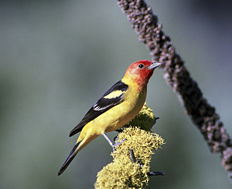
Recently split from Thraupidae
Related to ArremonopsArremonops
Arremonops is a genus of neotropical birds in the Emberizidae family. All species are found in Central America, Mexico, and/or northern South America...
and other American sparrows in Emberizidae
Emberizidae
The Emberizidae are a large family of passerine birds. They are seed-eating birds with a distinctively shaped bill.In Europe, most species are called buntings. In North America, most of the species in this family are known as sparrows, but these birds are not closely related to the sparrows, the...
:
- Genus ChlorospingusChlorospingusChlorospingus, the bush-tanagers, are a genus of perching birds traditionally placed in the tanager family . This seems in error according to more recent studies, which suggest that they are closely related to the genus Arremonops in the Emberizidae...
– bush-tanagers (around 10 species)
Related to the cardinals
Cardinal (bird)
The Cardinals or Cardinalidae are a family of passerine birds found in North and South America. The South American cardinals in the genus Paroaria are placed in another family, the Thraupidae ....
in Cardinalidae:
- Genus PirangaPirangaPiranga is a genus of birds long placed in the tanager family, but now considered relatives of the Cardinalis cardinals.Similar in shape and habits to the true tanagers, their coloration betrays their actual relationships. They are essentially red, orange or yellow all over, except the tail and...
– northern tanagers (9 species) - Genus Habia – ant-tanagers or habias (5 species)
- Genus ChlorothraupisChlorothraupisChlorothraupis is a genus of bird in the family Cardinalidae. It was long considered to be tanagers as their common names suggest, but this is false...
(3 species) - Genus AmaurospizaAmaurospizaAmaurospiza is a genus of birds. These "seedeaters" were formerly associated with the American sparrows and placed in the Emberizidae or the Fringillidae. The generic name is derived from the Ancient Greek amauros + spiza .Actually, they are part of the tanager-cardinal lineage...
(4 species; apparently very close to CyanocompsaCyanocompsaCyanocompsa is a genus of cardinal in the Cardinalidae family.It contains the following species:* Ultramarine Grosbeak * Blue Bunting * Blue-black Grosbeak...
) - Genus SpindalisSpindalisSpindalis is a genus consisting of 4 non-migratory bird species. The genus is considered endemic to the Greater Antilles; a population on Cozumel Island, off the Yucatán Peninsula's east coast, is part of that island's West Indian fauna...
– spindalises (4 species).
Fringillidae, subfamily Euphoniinae
Euphoniinae
Euphoniinae is a subfamily of finches endemic to the Neotropics. It contains two genera, Euphonia and Chlorophonia.-Species list:SUBFAMILY EUPHONIINAE*Genus Euphonia: the euphonias** Jamaican Euphonia, ** Plumbeous Euphonia, ...
:
- Genus EuphoniaEuphoniaEuphonias are members of the genus Euphonia, a group of Neotropical birds in the finch family. Euphonia contains close to 27 species. They and the chlorophonias comprise the subfamily Euphoniinae....
(over 25 species) - Genus ChlorophoniaChlorophoniaChlorophonia is a genus of finches endemic to the Neotropics. The English group name for the five species that constitute the genus is also chlorophonia. The collective term for the genus is chlorophonias...
(5 species)
External links
- Jungle-walk.com Tanager pictures
- Tanager videos, photos and sounds on the Internet Bird Collection

